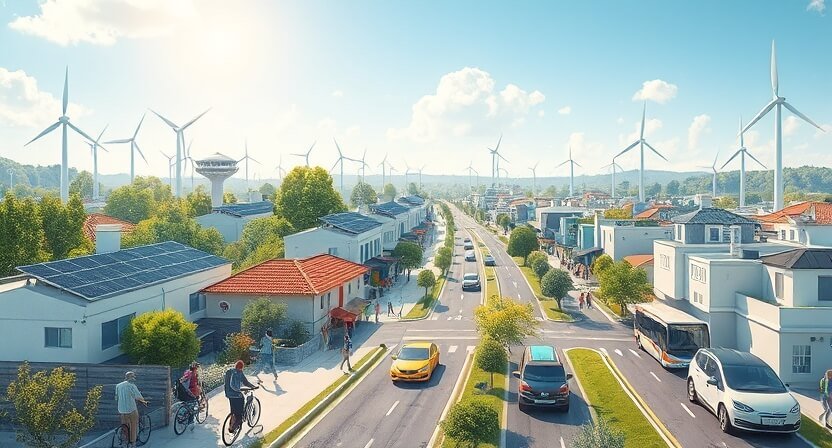
Sustainable Tech: Innovations Driving a Greener Future
Introduction: As the climate crisis intensifies, people are increasingly turning to technology to help combat environmental challenges. Sustainable technology is no longer just a futuristic concept—it’s here, transforming industries, reshaping everyday life, and offering hope for a greener tomorrow. In this article, we’ll explore some of the groundbreaking innovations driving the shift toward a more sustainable world, focusing on their emotional impact, how they work, and how they’re making a tangible difference in our fight against climate change.
1. The Emotional Power of Sustainable Tech
For many, adopting sustainable technologies isn’t just about saving money or cutting emissions; it’s about making a personal connection with the planet. People are motivated by the desire to create a better world for their children and grandchildren. Sustainable technology provides a sense of accomplishment, offering both practical solutions and emotional fulfillment.
When individuals switch to clean energy, invest in electric vehicles, or choose sustainably-sourced products, they aren’t just taking action—they’re part of a larger, global movement. Every small step taken feels like a victory in the ongoing fight for a healthier Earth.
2. Clean Energy: Powering the Future
Solar and Wind Power: The push for clean energy is more powerful than ever. Solar and wind energy are the backbones of the renewable energy revolution. Solar panels are becoming more affordable and efficient, turning rooftops into power stations. Wind turbines, both on land and offshore, generate massive amounts of electricity, contributing to clean grids around the world.
Energy Storage: A major challenge with renewable energy is storing power for when the sun isn’t shining or the wind isn’t blowing. But innovations like advanced batteries and supercapacitors are solving this problem, allowing us to store surplus energy for use during less productive periods.
Emotional Appeal: There’s a profound sense of hope tied to renewable energy. For those who adopt solar panels or invest in wind power, it’s a visible, physical manifestation of their commitment to a sustainable future. Every watt of solar energy harnessed is a small victory for the planet.
3. Sustainable Transportation: Driving Change
Electric Vehicles (EVs): One of the most noticeable innovations in recent years is the rise of electric vehicles. Companies like Tesla, Rivian, and traditional automakers are racing to develop electric cars, trucks, and even buses. These vehicles are not only reducing carbon emissions but are also becoming more affordable and efficient. Innovations in EV battery technology and expanding charging infrastructure are making electric cars an increasingly viable choice for consumers.
Charging Infrastructure: With the growth of electric vehicles, the development of a reliable and widespread charging network is essential. Innovations in fast-charging stations and wireless charging are making it easier for consumers to embrace EVs without worrying about battery life.
Emotional Impact: For many, driving an EV is a direct expression of their environmental values. It’s an emotional choice—an everyday action that contributes to a cleaner planet, less pollution, and a reduction in the oil dependency that has shaped the modern world.
4. Sustainable Agriculture: Tech Feeding the World

Vertical Farming and Hydroponics: As urban populations grow, traditional farming faces space and resource limitations. Vertical farming and hydroponics are reshaping how we produce food. These systems use less water and land while growing food more efficiently in controlled, indoor environments. Some cities are already using these technologies to grow crops in the heart of urban areas, reducing the need for long-distance transportation.
AI and Precision Agriculture: Modern farming is becoming more data-driven, with artificial intelligence (AI) and machine learning being applied to monitor soil health, optimize irrigation, and even predict weather patterns. Precision agriculture technologies enable farmers to use resources like water and fertilizers more efficiently, leading to less waste and greater sustainability.
Emotional Connection: The desire for sustainable, locally-grown food has surged. Consumers are becoming more conscious of where their food comes from and how it’s produced. With innovations like vertical farming, people can feel empowered knowing their food is grown using sustainable methods, reducing waste and supporting eco-friendly practices.
5. Waste Management and Recycling: Turning Trash Into Treasure
Smart Waste Management: Cities are increasingly adopting smart waste management systems powered by Internet of Things (IoT) sensors. These systems optimize trash collection, reduce energy use, and increase the efficiency of recycling processes. By using data to predict when bins are full and where waste should go, cities can reduce emissions from trucks and ensure recyclables don’t end up in landfills.
Circular Economy: The circular economy is gaining traction, encouraging businesses to design products that can be reused, refurbished, or recycled. Instead of throwing away items, we’re seeing the rise of upcycling—turning discarded materials into new products, reducing waste, and conserving resources.
Emotional Motivation: Every time a consumer recycles or supports businesses that use upcycled materials, they’re contributing to a cleaner environment. It’s a powerful emotional incentive when individuals realize that their actions are directly helping reduce the massive waste problem.
6. Green Building Technologies: Sustainable Homes and Cities

Smart Homes and Energy Efficiency: Smart thermostats, energy-efficient appliances, and home automation systems are transforming how we manage energy in our homes. These technologies allow for better control over electricity consumption, reducing waste and lowering utility bills. Automated systems also ensure that homes consume less energy, whether it’s heating, cooling, or lighting.
Sustainable Architecture: Green architecture is another growing trend, focusing on buildings designed with sustainability in mind. From passive house designs to using recycled materials and green roofs, architects are creating structures that are more energy-efficient and environmentally friendly. These innovations are leading to more sustainable cities and communities.
Emotional Fulfillment: Living in a sustainable home gives people a sense of pride and accomplishment. It’s more than just about saving money—it’s a tangible way to contribute to environmental conservation and support the growth of green cities.
7. Water Conservation: Tech Innovations for a Precious Resource
Smart Water Systems: Technologies like smart irrigation systems, water-saving fixtures, and leak detection sensors are revolutionizing how we manage water. In agriculture, smart irrigation ensures that crops get the right amount of water, reducing waste and ensuring crops grow efficiently.
Desalination: For communities facing water scarcity, desalination technology is becoming a game-changer. By converting seawater into potable water, desalination plants provide fresh water to areas that need it most.
Emotional Value of Water Conservation: Water is life, and for many people, conserving it is an emotional priority. Knowing that we are using technology to protect and manage this precious resource brings a sense of responsibility and urgency to act.
8. The Future of Sustainable Tech: What Lies Ahead?
The future of sustainable technology looks even brighter. From carbon capture to green hydrogen, the innovations on the horizon are poised to solve some of the world’s most pressing environmental challenges. Emerging technologies like bio-based plastics, algae-based fuel, and carbon-neutral production methods are all part of the growing sustainable tech landscape.
Collaborative Efforts: Achieving a truly sustainable future requires collaboration between governments, businesses, and consumers. Technological advancements are only part of the equation; collective action is needed to ensure that these innovations are scaled and adopted globally.
Emotional Appeal for Change: The future is full of hope and possibility. Every innovation, every new tech breakthrough, is a step toward a cleaner, healthier planet. For individuals, adopting these technologies and supporting sustainable practices gives a sense of agency—a belief that we can create change.
Conclusion: A Greener Future Awaits Us

The innovations driving the sustainable tech revolution are not just about gadgets and machines; they represent a powerful movement toward a brighter, greener future. Every step we take—whether it’s switching to renewable energy, choosing electric vehicles, supporting sustainable farming, or embracing smarter waste management—brings us closer to a world where our actions benefit both the planet and future generations.
As we continue to face environmental challenges, the promise of sustainable technology is more than just a trend. It’s a call to action for everyone—individuals, businesses, and governments alike. By adopting these technologies, we become part of a global effort to heal the Earth, reduce our carbon footprints, and ensure that the world we pass on to future generations is healthier and more sustainable.
The emotional connection we feel to our planet, to our families, and to our communities is the driving force behind this movement. Each time we make a conscious choice to embrace sustainable tech, we are taking ownership of our future and protecting the beautiful world around us. The time to act is now—let’s step into a greener future together.
Summary: The Promise of Sustainable Tech
Sustainable technology is reshaping the way we live, work, and interact with the environment. From clean energy solutions like solar and wind power to innovations in electric vehicles, sustainable agriculture, and waste management, these technologies are not only helping us reduce our carbon footprint—they are creating a more hopeful, connected world.
The emotional power of these technologies lies in their ability to bring us together for a common cause: protecting the planet and improving the quality of life for generations to come. Every innovation in this space is a reminder that we have the tools to make a difference. Whether it’s powering our homes with renewable energy or growing food in more sustainable ways, these technologies allow us to take meaningful steps toward a better future.
By embracing sustainable tech, we can turn our hopes into reality, creating a world where innovation and environmental consciousness go hand in hand. Now is the time to embrace the change—because a greener, brighter future is within our reach.
FAQs: Sustainable Tech and the Greener Future
1. What is sustainable technology, and why is it important?
Sustainable technology refers to innovations that reduce environmental impact, conserve resources, and help fight climate change. It’s important because it offers solutions to some of our most urgent global challenges, such as energy consumption, waste, and carbon emissions. By adopting sustainable tech, we can protect the planet for future generations.
2. How does clean energy help fight climate change?
Clean energy, like solar and wind power, generates electricity without emitting harmful greenhouse gases. By switching to renewable energy sources, we reduce our reliance on fossil fuels, decrease air pollution, and slow down global warming—taking an active role in creating a healthier world.
3. Why should I consider switching to an electric vehicle (EV)?
Electric vehicles (EVs) are better for the environment than traditional gasoline cars because they produce zero emissions. By driving an EV, you’re not just saving money on fuel—you’re contributing to cleaner air, reducing your carbon footprint, and supporting a sustainable future.
4. Can technology really help solve the problem of food production and sustainability?
Absolutely! Technologies like vertical farming, hydroponics, and precision agriculture are revolutionizing how we grow food. These innovations use fewer resources, reduce waste, and allow us to grow food more sustainably, even in urban areas. It’s a powerful way to feed the world without harming the environment.
5. How does smart waste management work, and why is it important?
Smart waste management uses technology like IoT sensors to optimize the collection and sorting of trash. By ensuring that recyclables are properly processed and minimizing waste, it reduces landfill use and lowers carbon emissions. It’s a small change that has a big impact on reducing pollution.
6. How can I contribute to sustainable living in my everyday life?
You can start by making small changes, like using energy-efficient appliances, recycling, supporting green businesses, or choosing sustainable products. Every little step you take to reduce waste or save energy helps create a ripple effect that benefits the planet.
7. How do sustainable technologies make a difference emotionally?
Adopting sustainable technologies provides a sense of fulfillment and connection to the planet. Every time you make an eco-friendly choice, you’re contributing to a cause greater than yourself—protecting the Earth for future generations. It’s an emotional investment in a cleaner, greener world.
8. Is sustainable technology accessible and affordable for everyone?
While some sustainable technologies, like solar panels and electric cars, may require an initial investment, prices are dropping, and government incentives make them more accessible. Over time, the savings on energy bills or fuel costs make these technologies affordable and beneficial in the long run.
9. What role do businesses play in promoting sustainable tech?
Businesses are key players in the sustainable tech movement. They can adopt green technologies, reduce waste, and innovate new solutions to reduce their environmental impact. When businesses make sustainability a priority, it drives demand for more eco-friendly products and services, making green choices more accessible for everyone.
10. Can sustainable tech really create a greener future?
Yes! Sustainable technologies are making a real impact in reducing carbon footprints, conserving resources, and fighting climate change. When we embrace these innovations, we actively contribute to creating a cleaner, healthier planet for future generations. The future is in our hands, and the change starts now.
11. How do sustainable technologies help create jobs?
Sustainable tech isn’t just good for the planet—it’s also creating new job opportunities. From renewable energy installations to electric vehicle manufacturing and green tech startups, these industries are rapidly growing and providing careers that make a positive impact on the environment.
12. How does renewable energy compare to fossil fuels in terms of reliability?
Renewable energy sources like solar and wind have come a long way in terms of reliability. With advancements in energy storage technologies, renewable energy can now provide consistent power, even when the sun isn’t shining or the wind isn’t blowing. This makes it a strong competitor to fossil fuels, ensuring a sustainable energy future.
13. Can sustainable tech help reduce the environmental impact of my home?
Yes! Technologies like smart thermostats, energy-efficient appliances, and solar panels can help reduce your home’s energy consumption and carbon footprint. Simple changes like upgrading insulation or using energy-saving lighting also make a big difference in reducing your environmental impact.
14. How does sustainable farming help combat climate change?
Sustainable farming techniques, like regenerative agriculture, reduce soil erosion, enhance biodiversity, and increase carbon sequestration. By adopting eco-friendly practices, farmers can produce food in a way that helps the environment rather than harming it—fighting climate change one field at a time.
15. What are the benefits of electric vehicles beyond just the environment?
Electric vehicles (EVs) offer a quieter, smoother ride, lower maintenance costs, and the satisfaction of knowing you’re contributing to cleaner air. They also reduce reliance on oil and foreign energy sources, making our transportation system more secure and less vulnerable to supply disruptions.
16. How can businesses use sustainable tech to reduce their environmental footprint?
Businesses can implement sustainable technologies in various ways, such as switching to renewable energy, using energy-efficient equipment, and adopting zero-waste initiatives. By doing so, they not only lower their carbon footprint but also attract eco-conscious consumers who value sustainability.
17. How do sustainable technologies help with water conservation?
Sustainable technologies like water-efficient irrigation systems, rainwater harvesting, and smart plumbing solutions help reduce water wastage. These technologies ensure that we can continue to meet growing water demands without depleting precious resources, especially in regions where water scarcity is a concern.
18. Can sustainable tech improve the way we handle waste?
Yes! Innovations like waste-to-energy technologies, composting systems, and better recycling processes can help us manage waste more efficiently. These systems reduce landfill overflow, lower methane emissions, and allow us to recycle materials that would otherwise be discarded, giving them new life.
19. How does sustainable tech improve the quality of life for communities?
Sustainable tech can improve the quality of life by providing cleaner air, reducing energy costs, creating green jobs, and fostering stronger, more resilient communities. When people have access to green technologies, they enjoy healthier environments and greater economic opportunities, leading to a higher standard of living.
20. What are some of the biggest challenges facing sustainable tech adoption?
While sustainable technologies hold great promise, there are challenges such as high initial costs, limited infrastructure, and a lack of awareness. However, as technology continues to evolve, these obstacles are gradually being overcome, and with the right policies and support, a widespread shift to sustainability is possible.



